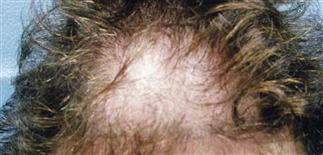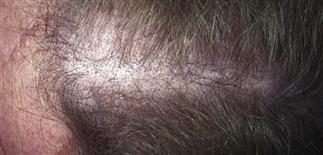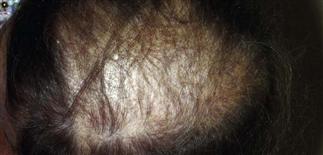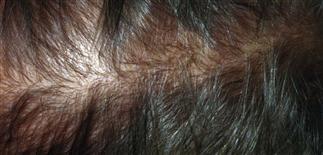150
Androgenic alopecia in women (female pattern hair loss)

Usually, the most obvious hair loss is from the frontal scalp. From Haber RS, Stough DB, eds. Hair Transplantation. London: Saunders; 2006.

The Christmas tree pattern indicates hair loss from the frontal scalp exceeding loss from occiput.

Diffuse thinning without inflammation on the crown of the scalp.

Widening of the part. Diffuse thinning without any scalp inflammation.
DESCRIPTION
Common hereditary, central, diffuse hair thinning that begins at a relatively early age. This is in contrast to postmenopausal hair loss that begins in women in their fifties, sixties, or seventies. Affected scalp hairs have shortened anagen cycle and progressive miniaturization of hair follicles.
HISTORY
• Inheritance is poorly understood; clearly a genetic predisposition. • May affect 6–25% of premenopausal women. • Women rarely become completely bald. • Hereditary hair thinning can begin in teenage years; two peaks of onset, in twenties and forties. • Gradual hair loss, not abrupt or massive. • Menses normal, regular. Heavy menses cause iron deficiency and increased hair shedding. Pregnancies normal; no infertility or galactorrhea. • Certain drugs cause hair thinning. Hair regrows when drug is stopped.
PHYSICAL FINDINGS
• Gradual hair loss on scalp crown with retention of normal hairline. • Widening of part often earliest visible change. Usually most obvious loss in frontal scalp. • Christmas tree pattern of loss indicates hair loss from frontal scalp exceeding loss from occiput. • Increased spacing between hairs, often pencil eraser-sized areas lacking hairs. • Many hairs miniaturized (thin and short). • Hair diameter becomes thinner. • Biopsy sometimes performed to rule out diffuse form of alopecia areata or telogen effluvium. • Most do not require hormonal evaluation. Typically, no signs of hyperandrogenemia, and serum androgen levels normal. • Dehydroepiandrosterone sulfate, serum-free or total testosterone, and prolactin levels should be determined if one or more present: irregular menses, hirsutism, virilization, cystic acne, galactorrhea, infertility. A subset may have polycystic ovarian disease and insulin resistance. • Other tests: thyroid-stimulating hormone. If heavy menses, serum iron, total iron binding capacity, and ferritin.
TREATMENT
• Topical 2% minoxidil solution (Rogaine) may be effective in some. It is applied twice a day for a trial of 6 months. If effective, must be continued for persistent effect. If there is no response, 5% solution is used twice daily; this is approved for use in men. • Patients with abnormal laboratory studies can be referred to an endocrinologist or a gynecologist. • No restrictions on frequency of washing, combing, hair coloring, or permanents. • Women with androgenic alopecia who desire an oral contraceptive should use a progestin with little androgenic activity, such as norgestimate or ethynodiol diacetate.







